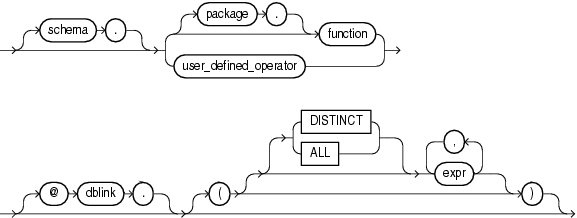About User-Defined Functions
You can write user-defined functions in PL/SQL, Java, or C to provide functionality that is not available in SQL or SQL built-in functions. User-defined functions can appear in a SQL statement wherever an expression can occur.
For example, user-defined functions can be used in the following:
-
The select list of a
SELECTstatement -
The condition of a
WHEREclause -
CONNECTBY,STARTWITH,ORDERBY, andGROUPBYclauses -
The
VALUESclause of anINSERTstatement -
The
SETclause of anUPDATEstatement
Note:
Oracle SQL does not support calling of functions with Boolean parameters or returns. Therefore, if your user-defined functions will be called from SQL statements, you must design them to return numbers (0 or 1) or character strings ('TRUE' or 'FALSE').
user_defined_function::=
The optional expression list must match attributes of the function, package, or operator.
Restriction on User-defined Functions
The DISTINCT and ALL keywords are valid only with a user-defined aggregate function.
See Also:
-
CREATE FUNCTION for information on creating functions, including restrictions on user-defined functions
-
Oracle Database Development Guide for a complete discussion of the creation and use of user functions
Prerequisites
User-defined functions must be created as top-level functions or declared with a package specification before they can be named within a SQL statement.
To use a user function in a SQL expression, you must own or have EXECUTE privilege on the user function. To query a view defined with a user function, you must have the READ or SELECT privilege on the view. No separate EXECUTE privileges are needed to select from the view.
See Also:
CREATE FUNCTION for information on creating top-level functions and CREATE PACKAGE for information on specifying packaged functions
Name Precedence
Within a SQL statement, the names of database columns take precedence over the names of functions with no parameters. For example, if the Human Resources manager creates the following two objects in the hr schema:
CREATE TABLE new_emps (new_sal NUMBER, ...);
CREATE FUNCTION new_sal RETURN NUMBER IS BEGIN ... END;
then in the following two statements, the reference to new_sal refers to the column new_emps.new_sal:
SELECT new_sal FROM new_emps; SELECT new_emps.new_sal FROM new_emps;
To access the function new_sal, you would enter:
SELECT hr.new_sal FROM new_emps;
Here are some sample calls to user functions that are allowed in SQL expressions:
circle_area (radius) payroll.tax_rate (empno) hr.employees.tax_rate (dependent, empno)@remote
Example
To call the tax_rate user function from schema hr, execute it against the ss_no and sal columns in tax_table, specify the following:
SELECT hr.tax_rate (ss_no, sal)
INTO income_tax
FROM tax_table WHERE ss_no = tax_id;
The INTO clause is PL/SQL that lets you place the results into the variable income_tax.
Naming Conventions
If only one of the optional schema or package names is given, then the first identifier can be either a schema name or a package name. For example, to determine whether PAYROLL in the reference PAYROLL.TAX_RATE is a schema or package name, Oracle Database proceeds as follows:
-
Check for the
PAYROLLpackage in the current schema. -
If a
PAYROLLpackage is not found, then look for a schema namePAYROLLthat contains a top-levelTAX_RATEfunction. If no such function is found, then return an error. -
If the
PAYROLLpackage is found in the current schema, then look for aTAX_RATEfunction in thePAYROLLpackage. If no such function is found, then return an error.
You can also refer to a stored top-level function using any synonym that you have defined for it.
